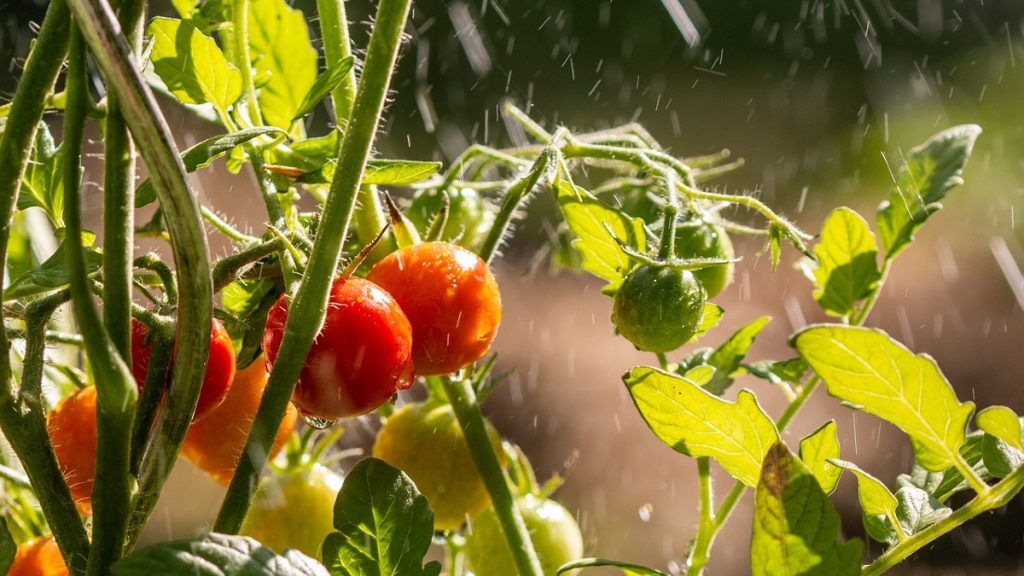As a home gardener, you know rain is vital for nourishing your plants. But when it comes to delicate fruits like tomatoes heavy downpours can actually cause more harm than good. So should you shield your tomato plants when rainstorms hit? Understanding the benefits and methods of covering tomatoes during rain can help safeguard your crop.
How Rain Affects Tomatoes
Before deciding whether to cover your plants it’s important to know how rainfall impacts tomatoes specifically. Here are some key effects
- Excess moisture encourages fungal diseases like early blight, late blight, and leaf mold. These thrive in wet conditions.
- Heavy raindrops can physically damage tomatoes by causing bruises, cracks, and splits. This increases risk of infections.
- Prolonged wet foliage creates an environment primed for pest infestations like hornworms or aphids.
- Overwatering from heavy rains can damage roots, leading to issues like blossom end rot on fruits.
While rain provides vital hydration, too much of a good thing can be detrimental to tomato health and production. Moderation is key.
Benefits of Covering Tomato Plants in the Rain
Shielding your tomato plants from downpours offers several advantages:
- Prevents moisture-loving diseases from taking hold and spreading.
- Protects fruits and foliage from physical harm caused by heavy raindrops.
- Allows you to control watering and avoid oversaturation of soil from rainfall.
- Creates ideal conditions for fruit ripening by keeping plants dry.
- Reduces pest infestations that thrive in damp conditions.
- Lets you monitor your plants closely and tend to any issues promptly.
Covering your tomatoes during rainstorms gives you greater control over their environment for optimal health.
Materials to Use for Covering Tomato Plants
If you decide to cover your tomatoes when it rains, you have several options:
- Plastic Sheeting – Heavy duty plastic is waterproof and affordable.
- Removable Fabric Covers – Allow airflow while repelling moisture.
- Cloches or Row Covers – Protect sections of plants or entire rows.
- Umbrellas – For container tomatoes; offers instant rain protection.
- Greenhouse – Ultimate rain protection in controlled setting.
- Wooden Frames – Build mini-shelters to cover small sections.
Choose a covering that suits your garden size, budget and needs. Just ensure it shields plants adequately.
Protective Measures Beyond Covering Plants
In addition to covering your tomatoes when it rains, here are some other protective measures to try:
- Improve drainage in planting beds so soil doesn’t get waterlogged.
- Use drip irrigation to deliver consistent moisture to roots without wetting foliage.
- Apply protective fungicides and pest deterrents before rain arrives.
- Prune leaves and stems to improve air circulation and light penetration.
- Use stakes, cages or trellises to keep plants off wet ground.
- Add organic mulch around plants to regulate soil moisture and temperature.
- Monitor soil moisture levels and refrain from overhead watering.
A multi-pronged approach makes tomato plants more resilient to rainy spells.
During rainy seasons, shielding your tomato plants helps control their environment, prevent disease issues, and reduce physical damage from pounding raindrops. But protection shouldn’t stop there – utilize preventive measures like mulching, pruning, and fungicides as well. Keep a close eye on your plants and be proactive in safeguarding them from harsh weather. A little extra care will help ensure a successful tomato harvest!
5 Tips to Save Your Vegetable Garden After Too Much Rain
FAQ
Is heavy rain bad for tomato plants?
At what temperature do tomatoes need to be covered?
Should I cover my plants when it rains?
Do tomato plants like to be wet?
Should tomato plants be under cover during the rain?
If your tomatoes are in pots or containers, you should consider bringing them under cover during the rain, but you don’t always need to do so. If you can judge how your tomato plants are doing, you should know whether you need to bring them inside or if you can let them enjoy the rainfall where they are.
Do tomato plants need to be covered?
If you live in an area with heavy rainfall, you may want to cover your tomato plants to protect them from wind and hail damage. If you are growing delicate tomato varieties, you may want to cover them to protect them from the elements. If your tomato plants are large, you may want to cover them to prevent them from being blown over by the wind.
How do you care for a tomato plant if it rains?
Tomato plants may suffer root and fruit damage following heavy rainfall. You may add cover the plants if suspecting a heavy downpour. You may remove the plants grown in pots, blot the excess water, and transfer them to a new pot. It is preferable to provide support, mulch, and prune the plants to reduce the damage due to rain.
Can Tomato plants get ruined if it rains?
However, in some cases, rain on tomato plants may cause more harm than good. If your tomatoes are in pots or containers, you should consider bringing them under cover during the rain, but you don’t always need to do so.
- The Ultimate Guide to Growing Strawberries in Raised Beds - August 8, 2025
- No-Dig Garden Beds: The Easiest Way to Grow a Beautiful Garden - August 6, 2025
- How to Protect and Preserve Wood for Raised Garden Beds - August 6, 2025

